-

kenwood kw-1100
 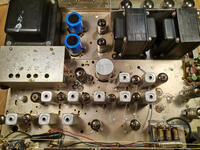
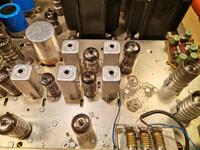
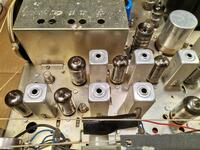

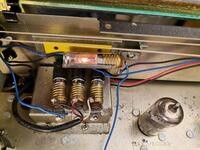
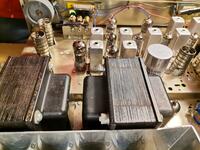
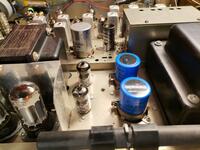
|
The
largest, heaviest and most powerful tube receiver made by
Trio / Kenwood. The only one that could compete with the
SANSUI 1000A. Produced only for two years 1965-66, because
at the same time Kenwood launched transistor models which
were replacing tube devices. Very classic look, aluminum
front with bakelite and aluminum knobs. When it comes to
BASS / TREBLE regulation, such a construction of these
knobs allowed separate regulation in each channel.
Bakelite was for "R" regulation and aluminum is for "L"
channel adjustment. The receiver also had an indication
system shown which input was used. While worked with a
tuner, the tuning indicator was illuminated in green,
which went out when switching to another input. The other
AUX, PHONO and TAPE HEAD inputs were coupled with "juvels"
illuminated in different colors on the right side of the
scale. The KW-1100 tuner in the FM part was the most
advanced in terms of automation and at the same time the
most modern among TRIO / Kenwood products. The FM head
had, in the first stage, the "fashion scream" of the
electronic miniature nuvistor lamp. A typical old 6AQ8 /
ECC85 tube cooperated with it. In addition, the same type
of lamp regulated the automatic frequency stability of the
FM head - AFC. It was interesting that the
constructors at the front placed an additional
potentiometer to adjust the width of the AFC, instead of a
switch as usually. The MPX decoder was also an interesting
design. It included two 6AW8 and 6AN8 tubes. The triode
part of the 6AW8 double tube was responsible for the
automatic switch-off of the stereo. It just turned off the
decoder when the signal was weaker. The stereo indicator
has been solved in an interesting way. It was an ordinary
light bulb hidden behind a window with the word STEREO.
Unfortunately, its brightness depended on the FM signal,
i.e. the better the signal, the brighter the STEREO sign
was illuminated. The radio part was complemented by the AM
track with the medium wave range.
The KW-1100 model was sold both under the Kenwood and Trio
brands, except that sometimes the letter "U" was added to
the numbers 1100. It meant the possibility of being
supplied with 115 or 230V and an extended FM range from 80
to 108 MHz.
The power amplifier in the KW-1100 was built on 7591 tubes
working in the Push & Pull arrangement. This
particular model still featured the original Hitachi 7591
tubes. All four were measured like new. 6AN8 tubes were
typical Japanese driver tubes. The standard 12AX7 / ECC83
tubes handled the entire preamplifier. The receiver had a
Mono / Stereo switch on the front (mainly for external
signals because the FM signal used the FM MONO / AUTOMATIC
switch) and a high-cut filter as MPX NOISE FILTER and a
low-cut filter as LOW FILTER. And of course the LOUDNESS
switch as standard for the company
In SANSUI 1000A, the power tubes were coupled through
capacitors with a capacity of 300 nF (currently available
value is 330nF). The Kenwood 1100 had 100 nF coupling
capacitors. As a result, the amplifier "did not extend"
very low, but also the bass signal was more "fast" and the
power tubes suffered less.
A unique design feature that distinguished the KW1100 from
all other tube receivers was the use of potentiometers
with the values used in transistor devices. While each
receiver (tube amplifier) had a voice potentiometer with
a value of 470 kOhm to 2.2 MOhm, in this KENWOOD product
the volume and balance were regulated by potentiometers
with a value of 100 kOhm. Nowadays, it makes servicing
much easier in the event of damage to these elements.
The KW1100 receiver had siblings. The brother was the
KW-220 power amplifier, and the sister was the KW-550
tuner. The KW-220 was practically a clone of the KW-1100
power amplifier. Minor functional modifications were made
and the BIAS voltage balance control system for the end
lamps was added. The tuner with the KW-550 symbol was also
a clone of the radio part of the 1100 amp. It was
advertised as "Automatic FM Stereo Tuner" which obviously
referred to the automatic switching off / switching on of
the MPX decoder depending on the strength of the MPX
signal.
The copy of the KW-1100 presented on the website was
purchased in the USA. It was very well modified which
prevented the lamps from working outside their regime. All
oil capacitors were replaced with other types. The voice
potentiometer was replaced, but the problem was the
balance potentiometer. It was replaced with the NOS Telpod
100k A with MN characteristics.
You would rarely listen to the amplifier using the
original 7591 HITACHI tubes with 100% emission. > One
of the photos shown a multimeter reading of 25.7 mV. After
conversion, it means a lamp current of 25.7 mA, which
exactly corresponded to the designed factory parameters.
The other vacuum components were also in excellent
condition.

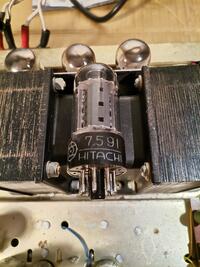

|
Main Page
Previous
Page
Contact
|